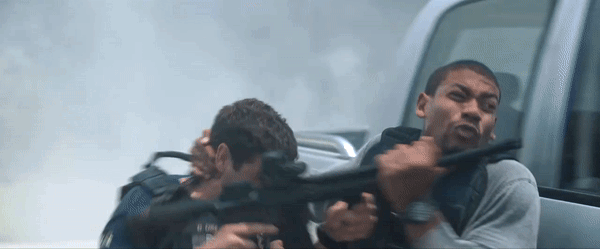Rebel Ridge needed ‘sloppy, clumsy’ action, says director Jeremy Saulnier
Jeremy Saulnier’s Thrilling New Netflix Film Rebel Back sits firmly in the action category. But where stylized hit action films like the John Wick series or the HiGH&LOW films benefit from over-the-top action stunts, the throwdowns in Rebel Back are simple and streamlined enough to be completely believable.
Previous notable Saulnier films such as Blue Ruin And Green room deal with violence in a graphic, bloody way, but they place the bloody conflict in reality. Rebel Back has a more blockbuster-like structure than those films in terms of direction and ending. But still, the fights are, as Saulnier repeatedly said in a preview with Polygon, deliberately and intentionally “sloppy.”
“I can see an action hero take out a whole building full of people, and I’m in awe of the stunt work,” Saulnier says. “The choreography is amazing, and I love doing that ride. But I really can’t feeling a lot. I don’t feel the harrowing nature of what you might experience when you’re up against another human being. So with (Rebel Back‘s) choreography, I was always there to thwart the stunt team’s attempts to make things cooler, bigger, more satisfying. Like, ‘Take it down a notch!’ or ‘I don’t think that would happen!’ I was always there to make it sloppy and uncomfortable.”
(Editorial note: Spoilers ahead Rebel Back.)
Rebel Back stars The Underground Railroad‘s Aaron Pierre as Terry Richmond, a black Navy veteran and martial arts instructor who visits a small Southern town to bail his cousin out of jail. He’s working to a strict deadline, with his cousin’s life on the line, but the white local police begin harassing him as soon as he arrives in town, stealing his bail money under the pretense of forfeiting civil assets and threatening him with jail time or worse if he fights back.
Terry is a polite, cautious, measured man. It’s hard to see Rebel Back without thinking Ta-Nehisi Coates’ Between the world and me and other prominent writings by and about Black parents having ‘the talk’ with their children about how to handle racially charged police encounters. Terry is clearly familiar with that dynamic and the importance of maintaining his composure even in the wake of outrageous provocations and overt bullying, and yet it’s clear that at some point he will explode and stand up to the injustice and abuse heaped upon him by the police — particularly local police chief Sandy Burnne (Don Johnson).
The entire film is one long, tense wait to see which straw will finally break Terry’s spine. And there’s a natural expectation that — like Sylvester Stallone’s similarly military veteran in the 1982 film First Bloodas he deals with similarly out-of-touch small-town cops — Terry will leave a trail of bodies in his wake if he finally loses control of himself.
But Saulnier didn’t want to Rebel Back to end on a wave of dramatic neck-snapping and body-pulverizing: He wanted “a traditional American action movie, ideally with more artistry.” And he wanted Terry to feel vulnerable.
“Aaron and I and the stunt team just worked very closely together. I did my research and I had seen how martial arts disciplines play out in the real world,” Saulnier says. “It’s basically sloppy wrestling and just brute strength. There’s definitely some technique and knowledge, but a lot of it is about leverage and positioning, not so much about complicated movements. Wire work never came into play, other than a few things to help people drop their weight. I leaned on my strength, which is an uncomfortable reality, and that allowed for a more real fighting space and more real hand-to-hand combat. And that, for me, led to a greater dramatic payoff — a greater emotional experience than these kinds of big spectacle movies.”
Saulnier laughs a little in our interview when he suggests that his stunt crew didn’t fully understand why he resisted traditional action until they saw the finished film. “We finally showed it to the crew in New Orleans last week, and I think they fully understood what I wanted — the emotionally charged, subjective experience of Terry Richmond fighting through these adversaries,” he says.
“There was a point where we had a choreography that was pretty amazing, and I was sitting in the edit room looking at it. And I was really proud of the work that we did, as a fan of MMA, and someone who has researched far more fights than I care to admit. But it didn’t feel real. So some of the coolest choreography ended up getting cut, because if it didn’t feel completely true, based on Aaron’s physicality and who he was up against, it had to go. That was painful, but gratifying. The letter to the stunt team was something like: We pay tribute to so many films, but we have to chart our own path and make this its own genre.”
Part of that big emotional payoff was that Terry and his allies in the film got a more positive ending than fans of Saulnier’s other work might have expected. “I think people are going to be surprised when they finally see this film, because of the nuances and the layers that are there, and the predicament that everyone is in,” Saulnier says. “I don’t want to condone any behavior, but I just want to understand why we as humans are in this conflict — and hopefully provide a little bit of catharsis, which is new for me. You know, I’m used to a movie that’s really slapped me in the face, leaving the audience in shock or fear. And this film, I think, transcends that boundary. We’ve had almost euphoric reactions. When you hear people in a theater experiencing this film together — it’s really heartening and bizarrely uplifting.”
Rebel Back is now available on Netflix.

